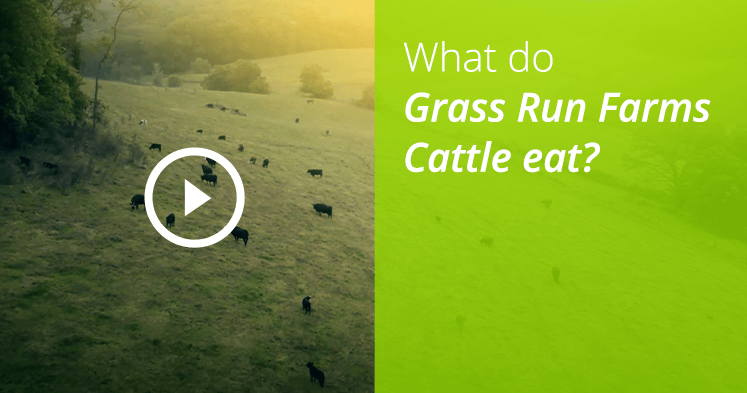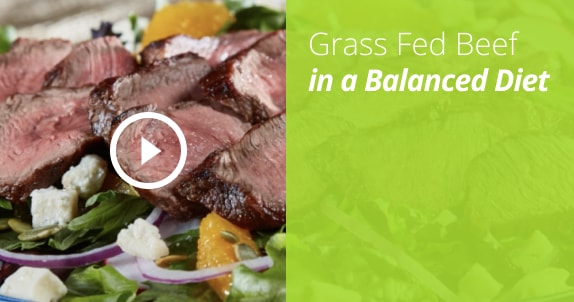General
What is 100% grass fed beef?
All cattle consume grass and forages during some point during their lives. 100% grass fed beef, or grass finished beef, is sourced from cattle that have consumed only forage diets (no grain) their entire lives.
Is grass fed beef tender?
There are many factors that affect meat tenderness, including genetics (breed), age, nutrition, quality grade (the amount and distribution of marbling) and the preparation technique.
Does grass fed beef taste different?
Due to the forage on which cattle graze, grass fed beef sometimes offers a slightly different flavor profile. Grass Run Farms focuses on delivering a consistent, quality experience with a rich, beefy flavor that you would experience eating grain-finished beef.
Does grass fed beef smell different?
No, there are no differences in smell between grass fed beef and other types of beef.
What is natural beef?
Natural beef is defined by the USDA as beef that is minimally processed, with no artificial ingredients.
What is ungraded beef?
Ungraded beef is beef that has not been graded by the USDA’s Agricultural Marketing Service. There is no federal requirement that beef must be graded. The grading of beef is voluntary, and companies, butchers, or grocery stores can choose to grade beef themselves. Grass Run Farms products include those graded by the USDA as well as ungraded products equivalent to USDA Select. For more information, see Inspection and Grading: What are the Differences?.
About Grass Run Farms
What makes Grass Run Farms beef different?
Grass Run Farms is a natural*, grass fed beef program in which cattle never receive antibiotics or added hormones. Grass Run Farms cattle are born, pasture raised† and harvested in the USA and sourced from Midwest farms. Grass Run Farms also practices humane animal welfare at harvest and has a commitment to sustainability. JBS Foods, which includes Grass Run Farms, pledged to achieve net-zero GHG (greenhouse gas) emissions by 2040. Here are the interim goals we’ve set on the path to net zero:
- Invest more than $1 billion in upgrading facilities and equipment by 2030
- Invest $100 million in research and development projects by 2030
- Reduce emissions intensity in all our facilities by 30% by 2030
- Use 100% renewable electricity by 2040
- Tie environmental performance to executive compensation to ensure accountability
*Minimally processed, no artificial ingredients added.
†Cattle must have continuous access to pasture during grazing season.
Do Grass Run Farms cattle ever receive antibiotics and added hormones?
Grass Run Farms cattle never receive antibiotics or added hormones.
Are Grass Run Farms cattle fed grain?
Grass Run Farms cattle are 100% grass fed and finished, and are not fed grain.

Are Grass Run Farms cattle fed soy?
Grass Run Farms program protocol allows for cattle to be fed soy hulls. Soy hulls are a grain-free, energy-rich food source and roughage for the rumen (digestive system of the cow). Soy hulls are never a large portion of the diet and cattle never receive any soybeans, soybean meal, or soy oil.
Where does Grass Run Farms source from?
Grass Run Farms strategically sources cattle from family farms in the Midwest throughout America’s heartland. Grass Run Farms cattle are born, pasture-raised†, and harvested in the USA.
†Cattle must have continuous access to pasture during grazing season.
Do Grass Run Farms cattle have access to pasture year-round?
Grass Run Farms cattle must be on pasture a minimum of 120 days. Cattle must have continuous access to pasture during growing season. Our cattle are raised in the Midwest, including Iowa, Nebraska, and South Dakota. Due to the weather, season and/or climate, the growing season in this area is the period between the last average frost in the spring and the first average frost in the fall within the production area. During the winter, cattle are fed from stored forages to protect them from harsh winter conditions.
About Grass Run Farms Beef Products
Is Grass Run Farms beef 100% grass fed and finished?
Yes, Grass Run Farms is 100% grass fed and finished beef. Our cattle consume forage diets their entire lives.
Is Grass Run Farms beef gluten-free?
Yes, all of our 100% grass fed and finished beef products, including hot dogs, are gluten-free.
Is Grass Run Farms beef GMO-free?
Our program protocol does not require that our producers include GMO-free grass in the feeding regimen. Therefore, we do not make that claim.
Is Grass Run Farms beef Organic?
Our program concentrates on raising grass fed and finished cattle without any grain, no added hormones, and no antibiotics. The program protocol does not require producers include organic grass and forage sources in the feeding regimen, therefore we do not make an Organic claim.
Where do I buy Grass Run Farms beef?
Grass Run Farms 100% grass fed beef is currently available in select retail and grocery stores. Visit our Where to Buy page to find a store near you.
We have partnered with Market House, an online modern marketplace for quality meats, to ship Grass Run Farms products directly to your door. Visit the Market House website.
What grade are Grass Run Farms steaks and roasts?
Grass Run Farms offers a variety of grass fed beef products including USDA Prime and USDA Choice graded, as well as products equivalent to USDA Select, to deliver a consistent, quality eating experience, every time.
What are IQF patties?
IQF, or individually quick-frozen, is a method of flash-freezing individual beef patties that prevents larger ice crystals from forming during the freezing process. Each patty is frozen individually, so you only have to use the number of patties you need for each meal.
How do I re-package my frozen beef patties?
Re-packaging your patties properly helps maintain quality and prevent freezer burn. It is safe to freeze your patties directly in the original packaging. However, the packaging is permeable to air and quality may diminish over time. We recommend overwrapping patties as you would any food for long-term storage. Fluctuations in temperature during storage can cause patties to form ice crystals that cause each patty to “stick” together. According to the USDA, storing foods at 0°F or lower will retain freshness, quality, nutrients, flavor, and texture.
Why are my frozen ground beef patties discolored?
Frozen beef products will naturally pale in color over time. The dulling of color from bright red to white may be due to a lack of oxygen, freezer burn, or prolonged storage. According to the USDA, food stored constantly at 0°F or below will always be safe, but lengthy freezer storage can impact quality.
Still concerned about the quality of your patties? First, check the odor. Any foods with a rancid or off-smelling odor after being frozen too long should be discarded immediately. You can also try the following test: simply press your thumb down on the patty for a few seconds and lift it. Your body heat will melt away the ice on the surface, and the beef should be pink where your thumb was.
What if the beef patties have freezer burn?
Freezer burn is caused by air coming into contact with the surface of the food and causes spotting. According to the USDA, freezer burn does not make food unsafe to eat. However, heavily freezer-burned foods may have to be discarded for quality reasons.
What ingredients are used in grass fed beef hot dogs?
Grass Run Farms Uncured Beef Hot Dogs are made using 100% grass fed beef, with no nitrates or nitrites added. Our hot dogs are gluten and MSG-free.
The natural spices in our Uncured Natural Beef Hot Dogs include paprika, turbinado sugar, celery powder, and onion powder. The natural flavoring is rosemary extract.
Where can I find coupons for Grass Run Farms products?
View coupons on our website and follow Grass Run Farms on Instagram and Facebook to keep up to date on current offers.
What is filet mignon?
Cut from the beef tenderloin (part of the loin primal), filet mignon is widely seen as one of the most tender cuts of steak. Filet mignon, also sometimes called beef tenderloin, is excellent for beef lovers who enjoy rich, tender flavors and are looking for a lean, smaller portion size. Try Grass Run Farms tenderloin steak.
Cooking Grass Fed Beef
How do I cook grass fed beef?
Cooking grass fed beef is similar to cooking other types of beef. When cooking beef, it is helpful to choose methods that work best for the specific cut you are using. Get cooking tips or browse recipes to learn more about preparation and cooking methods for your specific Grass Run Farms 100% grass fed beef cut.
How do I reverse sear a steak?
Reverse searing is a method of cooking steak that starts with cooking it in the oven, and ends in quick sear on each side of the steak in a hot pan. Reverse searing results in an evenly cooked steak with a nice crust and hearty flavor. Check out our video tutorial.
Food Safety for Beef Preparation
How long can grass fed beef stay in the refrigerator?
For best results, use grass fed beef within one week of refrigerating. Shelf life varies based on a number of factors, so always consult the packaging for recommended best-by dates.
What is the safest temperature to which to cook ground beef?
For optimal food safety, always cook ground beef to 160 degrees Fahrenheit.
What is the safest temperature to which to cook steaks or roasts?
For optimal food safety, always cook steaks and roasts to 145 degrees Fahrenheit.
Beef Nutrition
How does grass fed beef fit into a balanced diet?
Not only is grass fed beef incredibly delicious, but it is nutrient-rich. It’s a great protein choice for a balanced diet and provides healthy doses of 10 vitamins and minerals including iron, zinc, selenium, choline, phosphorus, and four B-vitamins. Learn more about beef’s nutrients.

Is beef heart healthy?
Studies show that lean beef in a balanced, low saturated fat diet is just as effective as chicken and fish in lowering total cholesterol and LDL. A recent study found that eating 3.5 or more servings vs. 3.5 or fewer servings of red meat per week did not affect risks of heart disease, cholesterol, or blood pressure. In short, beef is delicious, nutritious, and good for you.




